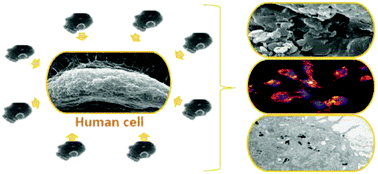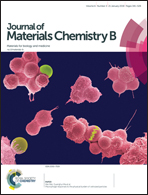Internalization studies on zeolite nanoparticles using human cells†
Abstract
Zeolites are crystalline porous materials with a regular framework which have non-toxic effects on a variety of human cell lines and have been explored for cell imaging and drug delivery. Understanding the interaction between zeolite nanoparticles and cells is imperative for improving their potentialities, since the process of internalization of these particles is still poorly understood. In this study, the intracellular trafficking and internalization kinetics of zeolite L into breast cancer cells and normal epithelial mammary cells were analysed using scanning electron microscopy (SEM), confocal microscopy and transmission electron microscopy (TEM). We also studied the involvement of endocytic pathways using two pharmacological inhibitors, chlorpromazine and dynasore. Zeolite nanoparticles were taken up by both cell types and the cellular uptake was fast, and started immediately after 5 min of incubation. Interestingly, the uptake was dependent on the cell type since in breast cancer cells it was faster and more efficient, with a higher number of nanoparticles being internalized by cancer cells over time, compared to that in the epithelial mammary cells. TEM results showed that the internalized nanoparticles were mainly localized in the cell vacuoles. The data obtained upon using endocytic pharmacological inhibitors suggest that the zeolite L uptake is mediated by caveolin.



 Please wait while we load your content...
Please wait while we load your content...